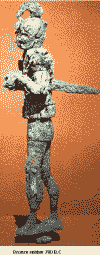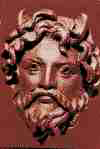750 BC - 612 BC: Cypro-Archaic 1 Assyrian rule of Cyprus; Seven
Cypriot Kings paid homage to Sargon II of Assyria (709 B.C)
Ten Cypriot Kings paid homage to Esarhaddon of
Assyria (673 B.C.)
The golden age of Archaic Cyprus when the island was divided between a dozen city
kingdoms, all independent.
 click to enlarge
click to enlarge
This was originally the ornate decoration of a chariot found at Salamis. It was
the lynch pin and was made in 700 B.C. What a beautiful piece.
568 BC - 525 BC: Egyptian rule.
In c.545 B.C. Cypriot Kings transferred allegiance to Cyrus the Great, king of Persia. Persian domination.
525 BC - 333 BC: Persian occupation and
the rule of the island; also termed as the Cypro-Classical period and the duel between
Kition and Salamis. Cyprus contributed 150 ships to the Persian fleet.
Then in 450 B.C. there was Cimons expedition to liberate Cyprus from Persia, but in 448
B.C. Cyprus is left firmly in the control of the Persians and Later Evagoras 1st became
the king of Salamis, by 391 he was the master of all Cyprus.
468 BC - 294 BC The
Kyrenia Ship Aleppo pine ship sheathed with lead and fastened with
copper nails. Carrying amphorae (jars) of Almonds and wine.
333 BC - 58 BC: End of Persian domination, death of
Alexander the Great, ( click here to read his
words) Hellenistic rule 1 & 11: the heirs of Alexander the Great rule the
island. until 88 B.C. when Cyprus was returned to Egyptian rule
 click to enlarge
click to enlarge
Silver coin minted at Kition 180-145 B.C.
58 BC - 395 AD: Cyprus is reduced to the state of a Roman province and
then in 47 B.C. Cyprus is returned to Egyptian rule by Julius Caesar
until the suicide of Cleopatra in 30 B.C. when Cyprus became part of the Roman Empire :
350 years of quiet provincial prosperity.
 click to enlarge
click to enlarge
Other side of the above coin
330 AD - 649 AD: The foundation of
Stavrovouni Monastery, within 10 years of each other Paphos and Salamis were ruined
by Earthquake and tidal wave (332 & 342 A.D.) In 649 The death of the lady
Umm-Haram, cousin of the Prophet at Tekke near Larnaca. The
island becomes a part of the Byzantine Empire when Cyprus is gradually converted from
paganism to Orthodox Christianity.
649 AD - 965 AD: A second Dark Age: The island is
caught on the frontier between the two warring empires of Byzantium and Islam.
965 AD - 1191 AD: Return of the island
to Byzantium.
1191 AD - 1192: Rule of the island by Richard the Lionheart, He
sold it to the Templars for 100,000 dinars. He married Berengaria of Navarre in
Limassol, where she was crowned queen of England. The Templars then re-sold the
island to King Richard who later transferred it at the same price to to Guy de Lusignan.
1192 AD - 1489 AD: Rule of the island
by the Frankish Lusignan dynasty.
1489 - 1570: Venetian domination of the
island.
1571 - 1861: Conquest of the island by
the Ottoman Empire.
 click to enlarge
click to enlarge
1878 - 1914: The administration of
Cyprus passes to Britain. Which remains formally part of the Ottoman Empire In 1880 Greek
and Turkish were established as the mediums for education in the schools
(Each to his
own)1914 Cyprus was annexed by Britain when the Ottoman Empire enters into the World
War I on the side of Germany; subsequently the island becomes a British Crown colony and
under the British rule.
1924 - 1960: Under the treaty of
Lausanne Turkey renounced claim to Cyprus in favour of Britain.
1959: Archbishop Makarios is elected
president.
1960: Foundation of the Republic of
Cyprus (by the Turkish and Greek Cypriot communities).
The treaty of Establishment with its various appendixes is drawn up and
signed
1963:President Makarios threatens changes to the constitution. Outbreak of
inter communal
fighting : Green line dividing communities in Nicosia were established.
The Turkish side withdraws from the power sharing agreement.
1964: The United Nations peacekeeping force
arrives. Enclaves are defended.
1974: Death of Grivas, leader of
campaign for Enosis (Union with Greece) Conspiracy against President Makarios inspired by
the Greek Junta , his overthrow, the declaration of Samson as President, invasion by
Turkish troops, Glafkos Clerides is acting President until President Makarios returns (December
7th). A very busy year.
1975: Rauf Denktash
becomes president of breakaway Turkish side. Start of inter
communal talks in
Vienna.
1977: Archbishop Makarios died. Spyros
Kyprianou elected as president.
1983: Talks between the two sides suspended by Denktash. He declares Turkish Republic of Northern Cyprus
which is recognised by no one but Turkey.
1988: George Vassiliou elected as
president and declares an end to bureaucratic lunacy. Promises people at
least a reply to letters.
1993: Glafkos Clerides elected as
president through proper channels this time.
1998: Talks continue
and collapse over the years. Glafkos Clerides elected for second term.
EU membership tentatively proposed. Missile crisis.
2001: Protests at Akrotiri British base over planned
telecommunications mast.
2002: Kofi Annan peace plan presented to incorporate
federation and a rotating presidency. A reunified Cyprus invited to join
EU an proviso both agree to UN plan, otherwise only Greek side to join.
2003: Tassos Papadopoulos elected President. UN plan passes
deadline. Borders opened for the first time in 30 years.
2004: Referendum on UN reunification plan accepted by Turkish
side but rejection by Greek side means no EU entry for them.
2005: Helios Air crash kills all people on board.
Turkish side hold elections won by Mehmet Ali Talat.
2006: Despite closer ties and continuing talks, Turkey refuses
to open its ports to Cyprus Republics traffic until EU ends the
isolation of the Turkish Cypriot community.
2007: Oil row, Turkey sends warships to Eastern med. Cypriots
from both sides demolish barriers in the centre of Nicosia on the Green
Line.
2008: Cyprus adopts the Euro. Goodbye Cyprus pound. Prices
rise again.
To be continued..........
*2006 - 2008 Addendum: A lot has happened in the last few years. We held
a referendum, the point of which was supposed to be ' Whether Cyprus
wanted to be in the European Union.' The word on the street was that we do
want the might of the United States of Europe to protect us from the
Turks. We joined. Prices rose rapidly (they still are,) so only the
super rich have benefited so far. There does seem to be a growing
awareness of social welfare for people and pets though, which means the
ball is rolling.
However it is not fair of me to waft on here, I
will take it to the meanderings page, just remind me, soon.
We just discovered how the big battalions don't
seem to care about the little people. Point in question will be understood
if you arrived here from the page url
thunderworx.com/main/resourceredirect.asp?l=2916
leading you to the belief that you are in
fact on a Thunderworx page. Not so, yet again, the power of .php and asp , which
is as I write (5th November 2006) ,is serving up a page, which is
copyrighted, to google consumers when they will not serve up the original!
History does tend to repeat itself doesn't it ? Update in 2008 - someone
must have read this, now it resolves to our URL. Oh the power of the
pen. Thank you
 click to enlarge
click to enlarge
Miniature bronze head of Zeus Ammon.325-30 B.C.
 click to enlarge
click to enlarge
Aphrodite 1st century B.C.
The story of a Hellenistic
mosaic discovery
This is a map of the accessible sites
and their old and new names.

Click to enlarge |